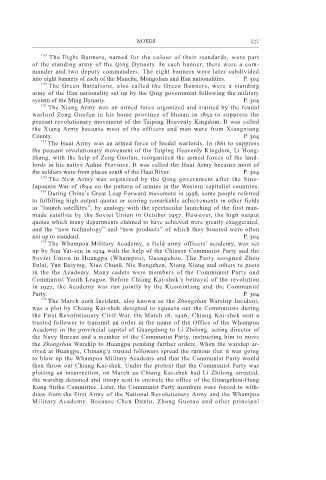Page 529 - SELECTED WORKS OF ZHOU ENLAI Volume II
P. 529
NOTES 527
139 The Eight Banners, named for the colour of their standards, were part
of the standing army of the Qing Dynasty. In each banner, there were a com-
mander and two deputy commanders. The eight banners were later subdivided
into eight banners of each of the Manchu, Mongolian and Han nationalities. P. 304
140 The Green Battalions, also called the Green Banners, were a standing
army of the Han nationality set up by the Qing government following the military
system of the Ming Dynasty. P. 304
141 The Xiang Army was an armed force organized and trained by the feudal
warlord Zeng Guofan in his home province of Hunan in 1852 to suppress the
peasant revolutionary movement of the Taiping Heavenly Kingdom. It was called
the Xiang Army because most of the officers and men were from Xiangxiang
County. P. 304
142 The Huai Army was an armed force of feudal warlords. In 1861 to suppress
the peasant revolutionary movement of the Taiping Heavenly Kingdom, Li Hong-
zhang, with the help of Zeng Guofan, reorganized the armed forces of the land-
lords in his native Anhui Province. It was called the Huai Army because most of
the soldiers were from places south of the Huai River. P. 304
143 The New Army was organized by the Qing government after the Sino-
Japanese War of 1894 on the pattern of armies in the Western capitalist countries.
144 During China’s Great Leap Forward movement in 1958, some people referred
to fulfilling high output quotas or scoring remarkable achievements in other fields
as “launch satellites”, by analogy with the spectacular launching of the first man-
made satellite by the Soviet Union in October 1957. However, the high output
quotas which many departments claimed to have achieved were greatly exaggerated,
and the “new technology” and “new products” of which they boasted were often
not up to standard. P. 304
145 The Whampoa Military Academy, a field army officers’ academy, was set
up by Sun Yat-sen in 1924 with the help of the Chinese Communist Party and the
Soviet Union in Huangpu (Whampoa), Guangzhou. The Party assigned Zhou
Enlai, Yun Daiying, Xiao Chunü, Nie Rongzhen, Xiong Xiong and others to posts
in the the Academy. Many cadets were members of the Communist Party and
Communist Youth League. Before Chiang Kai-shek’s betrayal of the revolution
in 1927, the Academy was run jointly by the Kuomintang and the Communist
Party. P. 304
146 The March 20th Incident, also known as the Zhongshan Warship Incident,
was a plot by Chiang Kai-shek designed to squeeze out the Communists during
the First Revolutionary Civil War. On Match 18, 1926, Chiang Kai-shek sent a
trusted follower to transmit an order in the name of the Office of the Whampoa
Academy in the provincial capital of Guangdong to Li Zhilong, acting director of
the Navy Bureau and a member of the Communist Party, instructing him to move
the Zhongshan Warship to Huangpu pending further orders. When the warship ar-
rived at Huangpu, Chinang’s trusted followers spread the rumour that it was going
to blow up the Whampoa Military Academy and that the Communist Party would
then throw out Chiang Kai-shek. Under the pretext that the Communist Party was
plotting an insurrection, on March 20 Chiang Kai-shek had Li Zhilong arrested,
the warship detained and troops sent to encircle the office of the Guangzhou-Hong
Kong Strike Committee. Later, the Communist Party members were forced to with-
draw from the First Army of the National Revolutionary Army and the Whampoa
Military Academy. Because Chen Duxiu, Zhang Guotao and other principal

